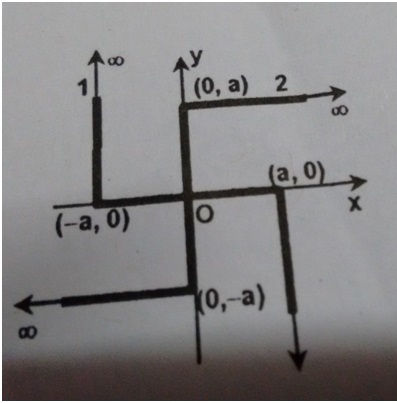What about these

Q1) If and and . Find and
Q2) Two non-conducting infinite wires have shapes as shown above. The linear charge densities of wire (1) and wire (2) are
and
respectively where are coordinates of points on the wire. An electron is released from origin, the unit vector along the direction of velocity of the electron just after its release will be in terms of and
No vote yet
1 vote
Easy Math Editor
This discussion board is a place to discuss our Daily Challenges and the math and science related to those challenges. Explanations are more than just a solution — they should explain the steps and thinking strategies that you used to obtain the solution. Comments should further the discussion of math and science.
When posting on Brilliant:
*italics*or_italics_**bold**or__bold__paragraph 1
paragraph 2
[example link](https://brilliant.org)> This is a quote# I indented these lines # 4 spaces, and now they show # up as a code block. print "hello world"\(...\)or\[...\]to ensure proper formatting.2 \times 32^{34}a_{i-1}\frac{2}{3}\sqrt{2}\sum_{i=1}^3\sin \theta\boxed{123}Comments
cosx+cosy+cosz=a
cos2x+cos2y+cos2z+2cosxcosy+2cosycosz+2cosxcosy=a2
Likewise, sin2x+sin2y+sin2z+2sinxsiny+2sinysinz+2sinxsiny=b2
Adding, cos2x+cos2y+cos2z+2cosxcosy+2cosycosz+2cosxcosy+
sin2x+sin2y+sin2z+2sinxsiny+2sinysinz+2sinxsiny=a2+b2
⟹1+1+1+2(cosxcosy+cosycosz+cosxcosy+sinxsiny+sinysinz+sinxsiny)=a2+b2
⟹3+2(cos(x−y)+cos(y−z)+cos(z−x))=a2+b2
⟹3+2∗2−3=a2+b2
0=a2+b2⟹a=0&b=0
Log in to reply
Thanks for this man.
@Raghav Vaidyanathan @Ronak Agarwal @Mvs Saketh
The answer to q 1 is very easy: a=b=0.
Log in to reply
Ans 2 q2 seems to be zero too.
Log in to reply
can u explain in brief the first part
Log in to reply
for first one The simplest way is to assume all the three angle differences equal, which ofcourse then must be 120 degree, so just consider 1 , w ,w^2 , add em up